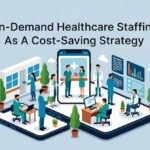In a world that increasingly thrives on data, the healthcare sector stands as a prime benefactor of this digital renaissance. As we step into an epoch marked by data-driven medicine, a compelling shift is underway. Statistic shows the size of the global big data analytics services market related to healthcare in 2016 and a forecast for 2025, by application. It is predicted that by 2025 the market for health-related financial analytics services using big data will increase to over 13 billion U.S. dollars.
The shift from traditional practices to a more data-centric approach isn’t just a trend – it’s a revolution. At the core of this change lies healthcare analytics.
Pioneering Frontiers: The Confluence of Tradition and Technology
Traditional medicinal practices, while grounded in years of research and experience, often lacked real-time adaptability. Now, enter healthcare analytics, which is the catalyst of change, offering an insight-driven approach that redefines patient care and healthcare strategies. Predictive analytics is now enhancing early disease detection rates at a higher pace, emphasizing a renewed focus on diagnostic precision.
The Depth and Breadth of Modern Healthcare Analytics
Recent statistics show that the healthcare analytics market is expected to reach $50.5 billion by 2024, reflecting its vital role. It’s not just about numbers or superficial data; it’s about deriving actionable insights, which can reshape patient outcomes and pre-empt potential medical challenges. A Health IT Analytics report indicates that 60% of healthcare providers use analytics for patient stratification to provide personalized care plans. Such plans harness information on genetics, lifestyle, and even socio-economic conditions to offer bespoke therapeutic strategies.
Genomic Data and Healthcare Analytics: A Revolutionary Merge
With the human genome now fully mapped, integrating this wealth of genomic data into analytics offers unmatched personalization in treatments. Healthcare analytics, when combined with genomic insights, can influence treatment plans and medication prescriptions, ensuring they’re tailored for each individual, reducing adverse drug reactions.
Predictive Analytics: Proactivity Over Reactivity
Instead of waiting for a patient to show symptoms, healthcare analytics offers the power to predict potential complications. Hospitals that have implemented predictive analytics have seen a 20% reduction in patient readmission, and drive $5 million in cost savings.
Empowering HDOs: Operational Excellence through Analytics
For Health Delivery Organizations (HDOs), healthcare analytics isn’t just a buzzword; it’s an operational savior. By understanding patient flow and optimizing clinical staff allocation through these analytics, HDOs can increase efficiency and drastically reduce costs. In fact, HDOs utilizing healthcare analytics have reported a notable increase in operational efficiency.
The Fusion of AI and Clinical Decision-making
Imagine a world where diagnostics is not just based on a doctor’s expertise but is enhanced by AI-driven insights. The merger of AI with clinical decision-making marks a transformative era in healthcare. AI-driven analytics harness vast data repositories, learning from patterns often imperceptible to human observation. This synergy augments clinicians’ expertise, facilitating precise diagnostics, individualized treatment plans, and predictive health outcomes. As AI models continually refine with emerging data, healthcare professionals are empowered to make decisions that are not only timely but also increasingly accurate, revolutionizing patient care in an unprecedented manner. AI in healthcare is projected to reach around USD 187.95 billion by 2030 and a significant chunk of this growth is driven by AI’s role in healthcare analytics, including diagnostics, prognosis, and treatment suggestions.
Collaborative Advancements: HDOs at the Helm of Analytic Transformation
The use of healthcare analytics necessitates rigorous ethical considerations. Health Delivery Organizations (HDOs) are the vanguard of this transformative journey. Encouraging interdisciplinary collaboration, HDOs have reported a 25% boost in innovation, all thanks to a synergized, data-driven approach. While the advantages are numerous, there’s an urgent need to address data privacy, security, and unbiased treatment. Recent GDPR regulations and the U.S.’s Health Insurance Portability and Accountability Act (HIPAA) are stepping stones to this journey.
Challenges & Ethics: Navigating the Complex Terrain of Healthcare Data
The potential for analytics is virtually limitless. As we gear up for the next decade, the emphasis should be on training, infrastructure, and fostering a proactive mindset among healthcare professionals.
Envision a future where healthcare analytics is seamlessly integrated into every medical decision, driving efficiency, accuracy, and personalized patient care. And as we embrace this future, platforms like Medigy play a pivotal role. Medigy, a one-stop-research-shop, offers communities, news, events, and feeds that help professionals discover, track, and evaluate the most effective digital health solutions and medical devices. As the digital health realm continues to expand, tools like Medigy will be invaluable in ensuring that professionals stay informed and equipped with the best resources available.
With a robust foundation in healthcare analytics, the future of medicine is not just bright—it’s revolutionary.
Read Also
- Essential Steps to Launch Your Own Optometry PracticeLaunching your own optometry practice can be a thrilling and fulfilling journey. However, it requires careful planning, dedication, and an understanding of what it takes to succeed. With the growth in demand for eye care, more and more individuals are seeking to start their own practices. But how do you get there? This guide walks… Read more: Essential Steps to Launch Your Own Optometry Practice
- Compounding Pharmacy: Personalized Medication SolutionsA compounding pharmacy plays a vital role in modern healthcare by providing customized medications tailored to the specific needs of individual patients. Unlike mass-produced drugs manufactured by pharmaceutical companies, compounded medications are prepared by licensed pharmacists who carefully combine, adjust, or modify ingredients to create a formulation that best suits a patient’s unique medical requirements.… Read more: Compounding Pharmacy: Personalized Medication Solutions
- The Best Business Decision a Surgeon Ever Made: Ordering a Medical Equipment AppraisalMost surgeons don’t go into medicine because they love spreadsheets, valuations, or negotiating buy-ins. They go into medicine because they want to operate, treat patients, and build something meaningful over time. For one surgeon, that mindset worked perfectly, until the day another surgeon decided to buy into his practice. That moment exposed a problem he… Read more: The Best Business Decision a Surgeon Ever Made: Ordering a Medical Equipment Appraisal
- Creative Approaches to Alleviating Healthcare Staff ShortagesHospitals and clinics are facing staff shortages, which makes it harder to take care of patients well. Finding simple and useful solutions is very important. Easy changes like flexible work hours, good training, and chances to grow can help staff stay happy. Technology, like online doctor visits and helpful tools, can make work easier. Smart… Read more: Creative Approaches to Alleviating Healthcare Staff Shortages
- Understanding the Role of Sterilizers in Healthcare FacilitiesHave you ever wondered how hospitals keep their equipment safe enough to use on dozens of patients every day? Most people never think about what happens behind the scenes, yet these hidden steps play a huge role in patient safety. Sterilizers are part of that system, working quietly to remove harmful germs before any instrument… Read more: Understanding the Role of Sterilizers in Healthcare Facilities
- Building Healthcare Access Where It’s Needed Most: A Local First ApproachHealthcare shouldn’t depend on where you live. But in the U.S., it often does. If you’re in a big city, you likely have options. If you’re in a small town or an underserved neighbourhood, it’s a different story. To fix this, more healthcare leaders are turning to a local-first approach. That means putting clinics and… Read more: Building Healthcare Access Where It’s Needed Most: A Local First Approach
- Revolutionizing Patient Engagement: Innovative Solutions for Improved Care and Treatment SuccessNavigating healthcare system can often feel overwhelming for patients. Between appointments, prescriptions, and treatment regimens, it’s easy for crucial details to get lost in the shuffle. That’s why effective patient engagement and support solutions are more important than ever. Companies like Serva Health, with their pharma hub services, are stepping up to ensure that patients… Read more: Revolutionizing Patient Engagement: Innovative Solutions for Improved Care and Treatment Success
- On-Demand Healthcare Staffing As A Cost-Saving StrategyThis is an exciting and challenging time for the healthcare industry. Technology is advancing almost faster than humans can keep pace. New legislation is creating fresh challenges for the future of healthcare, and the shifting population demographic continues to place more pressure on healthcare facilities. Amidst these changes, healthcare facilities are facing a critical staffing… Read more: On-Demand Healthcare Staffing As A Cost-Saving Strategy









